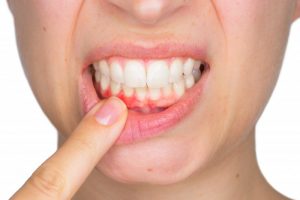 While bleeding gums can sometimes be caused by brushing or flossing your teeth too vigorously, the culprit is often gum disease. What does the latter entail, though, and how can your oral health be restored? Learn about two available methods of gum disease treatment in Arlington Heights and how you can regain a normal life with help from a local dentist.
While bleeding gums can sometimes be caused by brushing or flossing your teeth too vigorously, the culprit is often gum disease. What does the latter entail, though, and how can your oral health be restored? Learn about two available methods of gum disease treatment in Arlington Heights and how you can regain a normal life with help from a local dentist.
What is Gum Disease?
There are a chain-reaction of events that lead to gum disease. The problem starts with several hundred bacteria that have formed into a super-structure called plaque, a sticky substance that clings to the teeth and along the gum line.
If not removed, the plaque can eventually work its way beneath the gumline to form germ pockets. Untreated, the condition can develop into gingivitis (the first stage of gum disease), which is the inflammation of the gums.
Since February has been designated as National Gum Disease Awareness Month, the goal of dentists around the country is to bring attention to this condition and to encourage prevention and early detection.
The Warning Signs of Gum Disease
The following are some of the more common “red flags” to be on the lookout for:
- Receding gums
- Red spots on the gums
- Chronically-bad breath
- Bleeding when you brush
- Unpleasant taste in the mouth
- Puffy, swollen or irritated gums
If you notice any of the above warning signs, it’s important not to ignore them because untreated bacteria growth could contribute to the development of other health complications like heart disease, stroke, hypertension, oral cancer and tooth loss.
The Treatment Options for Gum Disease
Gum disease is not a condition you just have to settle for. With expert treatment, your oral health can be restored.
Here are two of the available options:
- Scaling and Root Planing – The scaling and root planing procedure involves two steps: the removal of bacteria beneath the gum line and the smoothing of the teeth roots to prevent any new bacteria growth.
- Antibiotic Therapy – In addition, the dentist may suggest antibiotic treatment applied beneath the gum line to kill any lingering bacteria.
While the above methods are excellent for restoring your oral health, prevention should always be the first priority.
Ways to Maintain Excellent Oral Health
It’s always easier to prevent bacteria growth than it is to treat it. The best ways are to brush and floss your teeth at least two times a day and to maintain regular appointments for cleanings and examinations. Then, if there are any unwanted developments, they can be addressed before they become troublesome.
So to get on the path to excellent oral health through either preventive or restorative measures, contact your dentist in Arlington Heights today.
About the Author
Dr. Ernie Costello is a graduate of the West Virginia University School of Dentistry. To stay abreast of the latest changes in the dental field and to continue to expand his knowledge, he maintains professional affiliation with such organizations as the Academy of General Dentistry, the Chicago Dental Society and the Illinois State Dental Association. Dr. Costello treats gum disease at Costello Dental, and he can be reached for more information through his website.
